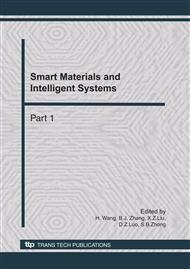[1]
GAO Yangyu, YANG Yang. Survey of Unconstrained Handwritten Chinese Character Segmentation [J]. Computer Engineering, 2004, 30(5): 144-146.
Google Scholar
[2]
WANG Kai, JIN Jian-ming, SHI Guang-shun. Chinese Font Recognition Based on Feature Point [J]. Journal of Electronics & Information Technology, 2008, 30(2): 272-276.
DOI: 10.3724/sp.j.1146.2006.01129
Google Scholar
[3]
FU Qiang, DING Xiao-qing, JIANG Yan. Segmentation and Recognition Algorithm for Chinese Handwritten Address Character String [J]. Journal of Electronics & Information Technology, 2008, 30(12): 2916-2920.
DOI: 10.3724/sp.j.1146.2007.00961
Google Scholar
[4]
ZHANG Yu-Jin. Image Engineering(1). BeiJing: Tsinghua University Press, 1999: 205-206.
Google Scholar
[5]
GAO Hong-bo, WANG Wei-xing . New connected component labeling algorithm for binary image[J]. journal of Computer Applications, 2007, 27 (11): 2776-2777.
Google Scholar
[6]
XU Zheng-guang, BAO Dong-lai, ZHANG Li-xin . Pixel Labeled Algorithm Based on Recursive Method of Connecting Area in Binary Images[J]. Computer Engineering, 2006, 32(24): 186-188.
Google Scholar
[7]
GE GONG-YAN, XU JJ-JIE, Wang MING-HUA. On the study of image characters location, segmentation and pattern recognition using LS-SVM [C]/ The 6th World Congress on Intelligent Control and Automation, Mar 3-7, 2006. Dalian: Institute of Electrical and Electronics Engineers Inc, 2006: 9650-9654.
DOI: 10.1109/wcica.2006.1713875
Google Scholar
[8]
ZHU KAI, QI FANG, Jiang R, et al. Using boost to detect and segment characters from natural scenes. In: Proceedings of the first International Workshop on Camera-Based Document Analysis and recognition, Apr 24-27, 2005. Seoul, Korea: IEEE computer Society, 2005. 52-58.
Google Scholar
[9]
HU QING-MAO, QIAN GUO-YU, NOWINSKI, et al. Fast connected-component labeling in three-dimensional binary images based on iterative recursion [J]. Computer Vision and Image Understanding. 2005, 99(3): 414-434.
DOI: 10.1016/j.cviu.2005.04.001
Google Scholar
[10]
HE LI-FENG, CHAO YU-YAN, SUZKI. Fast connected- component labeling [J]. Pattern Recognition. 2009, 42(9): 1977-(1987).
DOI: 10.1016/j.patcog.2008.10.013
Google Scholar
[11]
ZHANG Xiu-jun, GUO Xia, JIN Xin-yu. The Pixel Label Algorithm with Label Rectified of Connecting Area in Binary Pictures[J]. Journal of Image and Graphics, 2003, 8(2): 198-202.
Google Scholar


